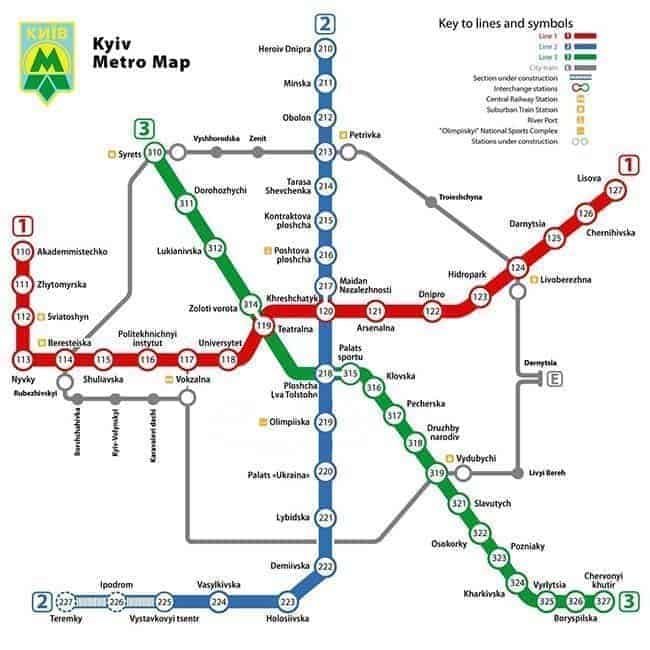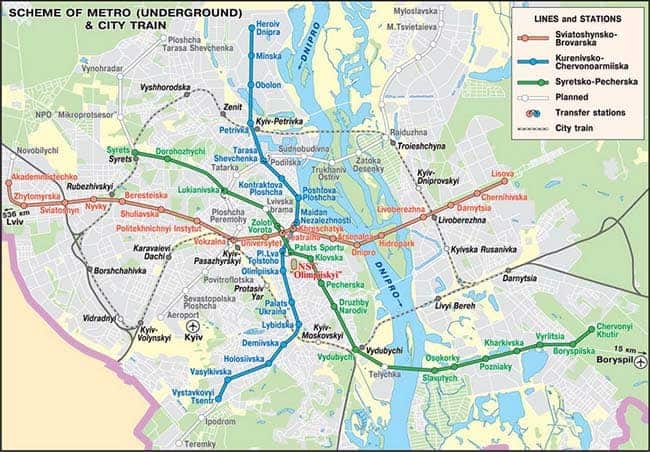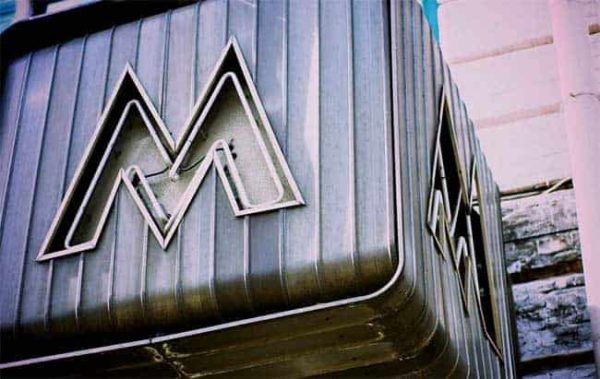Kyiv Metro Station Statistics
- 3 operating lines: red aka M1, blue aka M2, and green aka M3
- Covers 67.6 km (approximately 42 miles) in total distance
- Consists of 51 independent metro stations
- Services 1.3 million passengers daily
- Has operated for 50+ years
How Much Does the Metro Cost?
Riding the metro in Kyiv costs only 4UAH per ride (as of 10/2017 — that’s approximately $0.15 cents). Yes, you read that correctly – I said 15 cents (U.S.) per ride!
And if that’s not cheap enough, you can save even more money by buying 50 passes at once as the price will drop to just 3.5 UAH per ride! They’ll even give you a metro card to make riding quicker.
Now some of you reading this are undoubtedly asking how these prices are even possible.
Well, here’s what happened.
The local currency – the grivna – collapsed after the 2014 revolution. At the time one U.S. dollar was equivalent to eight grivnas whereas today one U.S. dollar buys ~ 26 grivnas. Imagine losing 3/4 of your savings overnight!
But let’s not digress into history too much. You’re after all only interested in the metro system, right?
Kyiv Metro Maps
So let’s look at two (2) maps of the metro system in Kyiv.
The first map lists each metro stop by the three lines (M1-M3) and is color-coded.
The second map is an overlay of the metro and the city’s streets. It’s helpful to see where each metro stop physically resides to grasp where you are and how to get there.
The trickiest part about the metro system in Kyiv are the double stops that appear below. Notice how Maidan Nezalezhnosti / 217 (blue line) and Khreshchatyk / 120 (red line) appear connected. This means you can stay underground and get from one to the other. There are three like this, for changing metro lines.


The remainder of the article provides a brief history of each metro stop.
Red Line (Sviatoshynsko-Brovarska line)
1. “Lisova”
Opened: December 5, 1979
Initially, the station was called “Pioneer” in honor of the international year of the child. Later on, in 1993, it was renamed “Lisova” (Forest), ostensibly because the station is located near a forest.
2. “Chernihivska”
Opened: October 4, 1968
The “Chernihivska” station was initially named “Komsomolska” after the political youth organization of the USSR. It was renamed “Chernihivska” in 1993 because two of its exits are to streets that merge onto highway E-95 (M01), which lead to Chernihiv.
3. “Darnytsia”
Opened: November 5, 1965
“Darnytsia” was never renamed. It’s named after a nearby historical area, which is located a few kilometers away. The origin of the name comes from the old Slavic language [darnytsia] (from the word “dar” meaning “gift”).
In the middle ages, there was a “sloboda” (settlement) with a local inn with bed and breakfast for the guests of the Duke of Kyiv.
4. “Livoberezhna”
Opened: November 6, 1965
Named after the Livoberezhny neighborhood meaning “left bank” as it’s located on the left bank of the Dnipro river.
5. “Hidropark”
Opened: November 5, 1965
“Hidropark” opened with an accompanying recreational area. The station is located on the Venetian island in the northern part of “Hidropark,” a park for culture and recreation.
6. “Dnipro”
Opened: November 6, 1960
“Dnipro” station got its name because it’s located at the foot of the Dnipro river.
7. “Arsenalna”
Opened: November 6, 1960
Named after the nearby factory “Arsenal.”
8. “Khreschatyk”
Opened: November 6, 1960
One of the station’s exits leads to the main street of Kyiv — Khreschatyk Street.
Khreschatyk comes from the Khreschaty Yar (“Cross Gully,” as it was crossed with beams). In the 17th century, the whole area was called the Kreschata Valley.
9. “Teatralna”
Opened: November 6, 1987
Originally named “Lenin,” in 1993, it was renamed into “Teatralna” (Theatrical) due to the nearby Lesya Ukrainka Russian Drama Theatre and National Opera of Ukraine.
10. “University”
Opened: November 6, 1960
The station is named after the National Taras Shevchenko University located nearby.
11. “Vokzalna”
Opened: November 6, 1960
“Vokzalna” is named according to its location near the Central and Suburban railway stations (Vokzal).
12. “Politekhnichnyi Instytut”
Opened: November 5, 1963
The station was named after the KPI (Kyiv’s Polytechnic Institute), which is nearby.
13. “Shuliavska”
Opened: November 5, 1963
Initially, the station was initially named “Zavod Bolshevik” (Bolshevik factory).
In 1993, it was renamed after the nearby historic area. The original name comes from the Old Slavic name “Shelvovi Borki.”
14. “Beresteiska”
Opened: November 5, 1971
Named in honor of the Brest-Litovsky avenue (now known as Peremohy avenue).
15. “Nyvky”
Opened: November 5, 1971
The station’s name means “field” in English and appears to be named after one that’s nearby.
16. “Sviatoshyn”
Opened: November 5, 1971
“Svyatoshyn” was named in honor of the Duke of Chernihiv.
17. “Zhytomyrska”
Opened: May 24, 2003
Named after the nearby highway that leads to Zhytomyr city.
18. “Akademmistechko”
Opened: May 24, 2003
Akademmistechko (scientific city) got its name from the surrounding area as there are several nearby scientific research institutes.
Blue Line (Kurenivsko-Chervonoarmiyska line)
1. “Ipodrom”
Opened: October 25, 2012
Named after Kyiv’s Horse Racetrack located near the station.
2. “Vystavkovyi Tsentr”
Opened: December 27, 2011
Literally: Exhibition Centre. Named after the nearby Exhibition Centre (a permanent trade show).
3. “Vasylkivska”
Opened: December 15, 2010
Named after the nearby street — Vasylkivska Street.
4. “Holosiivska”
Opened: December 15, 2010
The station is located in the Holosiiv area and so it bears its name.
5. “Demiivska”
Opened: December 15, 2010
The station was opened in 2010 and named after the Demiivskyi Market located nearby.
6. “Lybidska”
Opened: December 30, 1984
“Lybidska” is named after the nearby Lybid river. And this river, in turn, is named in honor of the mythical girl Lybid, the sister of the legendary founders of Kyiv.
7. “Palats Ukrayina”
Opened: December 30, 1984
Upon arrival, you’ll see the star of the Soviet Army. The station was initially named “Chervonoarmiyska” (for Red Army), but after nine years, it’s been renamed to Palats Ukrayina in honor of the National Palace of Arts of Ukraine.
8. “Olimpiiska”
Opened: December 19, 1981
This station was renamed 3 times — Republican Stadium, then Central Stadium, and today Olimpiiska (Olympic), which bears the name of the nearby Olimpiyskiy National Sports Complex.
9. “Ploscha Lva Tolstoho”
Opened: December 19, 1981
Named after the famous writer Leo Tolstoy.
10. “Maidan Nezalezhnosti”
Opened: December 17, 1976
Initially, when Ukraine was a part of the USSR, the station was named Kalinin Square, after the famous Soviet politician. It was renamed for the 6th anniversary of the October revolution to “October Revolution Square,” and then finally on August 26, 1991 (the year of Ukraine’s independence), it became “Maidan Nezalezhnosti,” or Independence Square.
11. “Poshtova Ploshcha”
Opened: December 17, 1976
During its construction, it was named “Rechnoy Vokzal” (for River Port) as the port is located in front of the station’s entrance. But eventually, it was named Poshtova Ploshcha (Postal Square) because the station itself is located right on the square with the same name.
12. “Kontraktova Ploshcha”
Opened: December 17, 1976
Initially named the “Red Square” and later renamed after the nearby neighborhood, Contract Square, where all the city’s contracts were signed since Kievan Rus’.
13. “Tarasa Shevchenka”
Opened: December 19, 1980
The station was named after the famous Ukrainian poet Taras Shevchenko.
14. “Petrivka”
Opened: December 19, 1980
“Petrivka” got its name from the nearby railway station. According to historical facts, this railway station and the entire nearby historical area known as Podil was called Petrivka (for the Petrovsky district) since the 1920-30s. The area was named after the famous revolutionary activist and Soviet party figure, Grigory Petrovsky.
15. “Obolon”
Opened: December 19, 1980
It’s named after Obolon, which is a district nearby. The word “Obolon” itself comes from the Old Slavic word “bolonnja”, which means water meadow.
16. “Minska”
Opened: November 6, 1982
The station got its name from the nearby Minsk district, in Minsk square.
17. “Heroiv Dnipra
Opened: November 6, 1982
The station is named after the nearby Heroes of Dnipro street.
Green Line (Syretsko-Pecherska line)
1. “Syrets”
Opened: October 14, 2004
“Syrets” is the name of a nearby area.
2. “Dorohozhychi”
Opened: March 30, 2000
Named after a nearby area called Dorohozhychi. The two words “doroho” and “zhyty” literally mean “expensive to live.”
3. “Lukianivska”
Opened: December 30, 1996
It’s named after a nearby location. According to research, this area was named after either a famous tailor, Lukian, who lived nearby, or a local farmer named Ihor Lukianenko.
4. “Zoloti Vorota”
Opened: December 31, 1989
Literally: Golden Gate. Not surprisingly, this station was named after the nearby historical site “Golden Gate.” During the reign of Yaroslav the Wise, the Golden Gates served a defensive function for Kievan Rus’. It turns out that the Golden Gate was named after the Gate in Byzantium.
5. “Palats Sportu”
Opened: December 31, 1989
This station is named after nearby Kyiv’s central Palace of Sports.
6. “Klovska”
Opened: December 31, 1989
At first the station was named “Mechnikova” in honor of Ilya Mechnikov, the Nobel Prize winner in Physiology and Medicine. In 1993, its name was changed to “Klovska” since the platform is located in “Klov.”
The word is derived from the Indo-European “klov,” which means “moisture or water.”
7. “Pecherska”
Opened: December 30, 1997
The station is named after the locality of Pechersk. The origin of the name is pretty obvious — nearby are the caves (“pechery” in Ukrainian) and the Kyiv-Pechersk Lavra.
8. “Druzhby Narodiv”
Opened: December 30, 1991
Literally: Friendship of Peoples. The platform is located directly under the Druzhby Narodiv Boulevard, so the name of this station is fairly obvious. With the name of the boulevard, locals immortalized Soviet help who reconstructed Kyiv after World War II.
9. “Vydubychi”
Opened: December 30, 1991
The station was named according to its location as it sits near the Vydubychi area.
According to a Slavic legend, the wooden figure of Perun went ashore (vydybala) at this place.
10. “Slavutych”
Opened: December 30, 1992
The “Slavutych” station is considered one of the most beautiful stations on the green line. “Slavutych” is a historical and folkloric name of the Dnipro river.
11. “Osokorky”
Opened: December 30, 1992
This metro stop was named for the nearby town, Osokorky (black poplar trees).
12. “Pozniaky”
Opened: December 30, 1994
“Pozniaky” was named after the nearby neighborhood, the land of which was originally purchased in 1631 by Leon Pozniak and Moses Pozniak.
13. “Kharkivska”
Opened: December 30, 1994
The station was named after nearby Kharkiv Highway, which is a route leading towards the city of Kharkiv.
14. “Vyrlytsia”
Opened: March 4, 2006
“Vyrlytsia” is one of the youngest stations in Kyiv. There’s a lake named Vyrlytsia right outside the station.
15. “Boryspilska”
Opened: August 23, 2005
The “Boryspilska” station is named after a road that leads to the city of Boryspil and the international airport.
16. “Chervony Khutir”
Opened: May 23, 2008
Literally: red farm. The station is located in the Chervony Khutir suburb.
"Kyiv is a bilingual capital, something unusual in Europe and unthinkable in Russia and the United States."
-- Timothy Snyder, The Road to Unfreedom: Russia, Europe, America


